Years ago, I went to the Phillippines for the first time for a short holiday. At the airport, while waiting to pass customs, I noticed a counter labelled “Balikbayan”. From what I understood at the time, it was a counter for processing overseas Filipino workers returning to their own country so that they don't need to suffer through a long wait at customs (like the rest of us do) upon arriving home.
During President Marcos' time in office, he extolled the virtues of being an overseas worker because by sending a good portion of their wages back to their families, they are helping the country's economy. This was an effective call to arms, resulting in thousands of Filipinos being recruited in various countries to do all kinds of blue-collar jobs. As of 2022, 8.9 percent of the Phillippines' GDP came from remittances, i.e. personal cash transfers between individuals that do not include business payments. That's about USD 36.14 billion worth of labour, sweat, and tears from these “modern-day heroes” as they are known in their own country.
The Philippines is just one example where remittances play a significant role in a country's economy. There are other countries where remittances represent a double-digit share of the GDP. Total remittance made globally amounts to $794 billion as of 2022, according to the World Economic Forum.
These payments are made through payment providers such as Western Union, Wise, banks, and any party involved in the transference of cash/value from one country to another. Their main revenue source comes from remittance fees. The global average of fees paid is around 7%, but it also depends on where the money comes from. That percentage is shared unequally amongst all the intermediaries that have even a pinky finger in the pie. For overseas workers, it is quite a hefty cut to their hard-earned earnings.
Fees aside, there are also regulatory checks and rules involved in funds transference that are aimed at preventing money laundering. This results in mandatory delays for the recipient of the funds, making this an expensive and tedious process.
It is against this backdrop that Ripple seeks to resolve the dual problem of slow and pricey transfers of value across borders.
Recently, Ripple has been making headlines as it scored a partial win in an early ruling of its 3-year-long court case against the US Security and Commissions (SEC) about whether its native token, XRP, is considered a security or not. As the crypto community celebrates this fragile win against the mighty SEC, I think this is the perfect time to understand more about Ripple as a project and how it wants to change the world.
Ripple XRP Review: Summary
The Ripple network is a real-time payment network that facilitates the movement of money and anything of monetary value across borders through an open-source infrastructure using the cheapest possible means in a trustless manner.
The Key Features of Ripple Are:
- No token mining - all tokens are pre-mined and a fixed supply
- Very low transaction cost for transferring money globally
- Near-instant settlement as each transaction takes less than 5 seconds to complete.
- Fast processing speeds - average number of transactions per second: 1500 transactions
Ripple Pros and Cons:
Ripple is an interesting crypto project because it seems to be unabashedly more centralised than most if viewed through the crypto punk lens. The project's main purpose is to help the banking system be more efficient but not to replace them. With this goal in mind, it gives the perception of being a kind of hybrid for these two worlds. The pros and cons below may illuminate how this arrangement works.
Pros of Ripple XRP
- Very low fees - Averaging $0.0001 - $0.0004 per transaction, these are some of the lowest fees you can find for transferring money. This helps to bring down the cost for the financial institutions utilising their service.
- Fast settlement - Transactions made on the network settle in under 5 seconds.
- Versatile exchange network - It offers transference of both crypto and fiat currencies around the world.
- Financial institution adoption - Ripple was designed with these institutions in mind as it aims to provide a fast settlement layer in the money transfer business. The institutions see the benefit of using Ripple and many may have already adopted it into their existing system.
- Low power consumption - all tokens are pre-mined so there is no need for grunty machines that use a lot of power, making it an eco-friendly solution.
Cons of Ripple XRP
- Highly centralised - most of the criticism of centralisation is aimed at the consensus style used, where what the majority of validators say goes. The validators themselves are a select group that has been approved by RippleLabs. The XRP token concentration by holders is also quite centralized.
- Large pre-mined XRP supply - About half of the supply is in an escrow account while the rest have already been distributed to founders and early investors. There is a risk of coins flooding the market, even if the token owners have a vesting schedule to keep them from doing so.
- SEC action against XRP - the SEC filed a lawsuit against Ripple in 2020, claiming that the tokens sold during the Initial Coin Offering (ICO) were securities and the subsequent sale to retail investors were securities. Their beef was that the necessary paperwork was not filed correctly, thus violating securities law. More on this in the section below.
- Token susceptible to price manipulation - as Ripple owns the majority of the tokens and no new ones will ever be created, even if they are undistributed, there is a risk that the price can be manipulated by bad actors.
A Brief History of Ripple
Who Created Ripple and Why?
It all started in 2004 when Ryan Fugger, a Canadian developer, created a “secure payment system for a financial network” called RipplePay. It was meant to work without banks, doing peer-to-peer lending instead.
A few years later, in 2011, Arthur Britto, Jed McCaleb, and David Schwartz teamed up to create what we know now as XRP Ledger. Its focus is on eliminating the 51% attack risk that Bitcoin is vulnerable to. A year later, Chris Larsen joined the team and has remained as the head honcho since. The group named their company OpenCoin. Note that this is where things went a bit murky as multiple sources had slightly different variations of who came first and who joined later. One version had McCaleb and Schwartz teaming up first and bringing Britto on board later; another version had Britto and McCaleb coming up with the idea of Ripple Labs and bringing in Larsen later.
Regardless, the general consensus is that the project had 4 members in total before McCaleb split with the group and created the Stellar project in 2013. Another noteworthy point is that McCaleb created Mt Gox, that infamous exchange that lost its users' Bitcoin and who are still waiting to be compensated.
Seeing the hodge-podge of networks and intermediaries used by the financial and banking sector for moving money around, usually resulting in delays and high costs for consumers, Ripple aims to provide banks and payment providers with an alternative solution for making payments that cost fractions of pennies and without the need for multiple intermediaries.
Banks saw the potential of what Ripple was doing and the RippleNet Committee was formed in 2015. It is an advisory team made up of big banks such as Merrill Lynch, Standard Chartered, Westpac, and Santander Bank in Spain. These investors were part of the early batch to test out Ripple's capabilities.
What is the Ripple Network?
The Ripple Network, often known as RippleNet, is a decentralised network of global banks and financial institutions that use a standard framework of payment rules to process real-time, trackable payments on-demand with minimal transaction costs. The key components that make up the network are:
- xCurrent - an enterprise-level software that enables banks to initiate and settle transactions. It's like SWIFT but a lot faster and without the middlemen.
- xVia - a payment interface for businesses that send payments on behalf of a customer to each other globally across various networks in a transparent manner using a standard API connection. Using xVia allows businesses to gain access to a vast network of banks and payment providers that are also on RippleNet.
- On-Demand Liquidity (ODL) - formerly known as xRapid, this product helps illiquid pairs swap with each other despite low liquidity for them. This is done by using XRP, the native token of Ripple, to be the intermediate token between the pairs.
- CBDC platform - Mint, manage, transact, and destroy CBDCs on a single platform.
Rather than disrupting the financial sector, Ripple seeks to enhance the current set-up by providing a better alternative that is much more efficient than what's already there. By choosing to partner with banks and various financial actors from the start, its ambition is to be the go-to settlement layer for the banking sector and the top network for payment providers involved in cross-border transactions. Basically, anything to do with moving funds, whether as a currency exchange network or a payment settlement system, is where Ripple wants to be. The $5 trillion forex market is a big juicy pear that Ripple wants to take a big bite of.
It also seeks to eliminate the need for nostro/vostro accounts held by banks, currently used to facilitate currency exchanges. These are accounts owned by banks in the other bank that they are transacting with. They are essentially the same accounts but recorded differently by the banks, depending on who owns the money. The bank that owns the money refers to the account as nostro, i.e. “our money with you”, and the bank that holds the money calls it “vostro”, i.e. "your money with us".
These funds need to be balanced regularly so that the account always has enough to make payments when needed, thus tying up capital that can be used in a more productive manner elsewhere.
The entire operation is built on a distributed open-source platform where not even RippleLabs, the creator, are able to make changes to it without gaining consent from the developers and network participants. Similar to the Ethereum Foundation's relationship to the Ethereum network, RippleLabs can only maintain the network and put forth suggestions in proposals that would be voted on by the network participants. This is a cornerstone piece to their claim that the XRP Ledger is a decentralized public blockchain.
In addition, AML & Fraud Protection for funds are implemented as part of RippleLabs' strategy to win over the bankers and financiers to give their platform a try. They've managed to secure a few clients of note including Santander Bank dogfooding into their investment and Siam Commercial Bank in Thailand to name a few.
What is Ripple's Technology?
We mentioned briefly earlier the key components that RippleNet is composed of. In this section, we'll look at them in more detail.
xCurrent
xCurrent is a Real-Time Gross Settlement system (RTGS), similar to SWIFT, with messaging capabilities for participants to clear and settle transactions whilst providing end-to-end tracking. Unlike SWIFT, payments are settled in a matter of seconds while SWIFT takes days on average. This enterprise-level software is targeted at banks and financial institutions that do large sums of cross-border payments involving liquid currency pairs. Since it is built on top of the Interledger protocol, banks can also exchange FX rates in real-time.
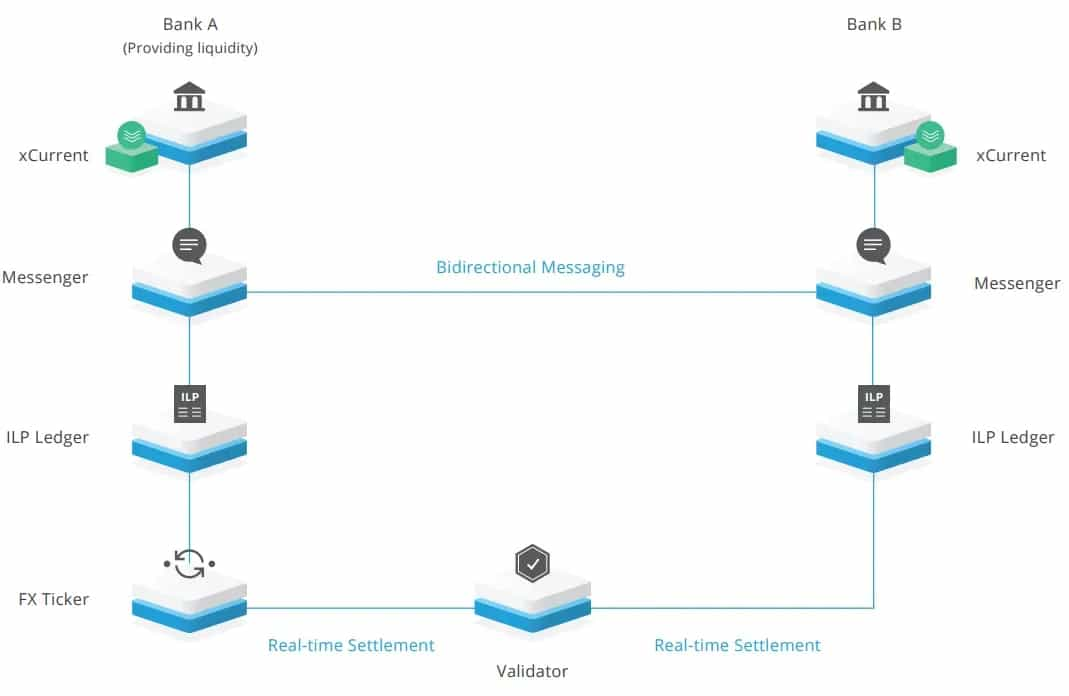
There are 4 components within the xCurrent layer:
- Messenger - this API-based messaging module that runs on TLSv1.2, enables secure communication with existing banking systems and ILP components of xCurrent. Transacting parties set relevant information related to the transaction, including FX rates that are defined in FX Ticker, another component. These rates are queried by Messenger as part of the transaction process. A payment ID is used to identify the payment in case anything occurs, making it easy to troubleshoot when things go wrong. Jurisdiction-specific regulatory needs are also defined as part of the program for regulatory purposes.
- Validator - the role of the validator is to verify and validate transactions that pass through the network. More on this role is discussed in the next section.
- ILP Ledger - this is the protocol that xCurrent runs on and is also discussed in the following section in detail.
- FX Ticker - exchanges rates are defined here by liquidity providers which are then applied as part of the Messaging service.
xVia
While xCurrent is designed to enhance the current banking systems to increase their efficiency, xVia is targeted at businesses and forex providers for sending payments to and from emerging markets without a bank account. Users do not need to install any kind of software. Instead, a standard API interface is available for users to access xCurrent, thus giving them access to a vast global network for payment providers.
xRapid
xRapid, now known as On-Demand Liquidity (ODL), is another product that works with both xCurrent and xVia. It is primarily used to source liquidity, especially in exchanges that involve illiquid pairs. XRP, the native token, is used as the bridge currency to facilitate these transactions. Ripple uses the buying fiat currency to buy XRP and sell it for the selling fiat currency on the other end. It also eliminates the need for nostro accounts, allowing smaller players in the financial sector to be on a much more levelled playing field with the big guys.
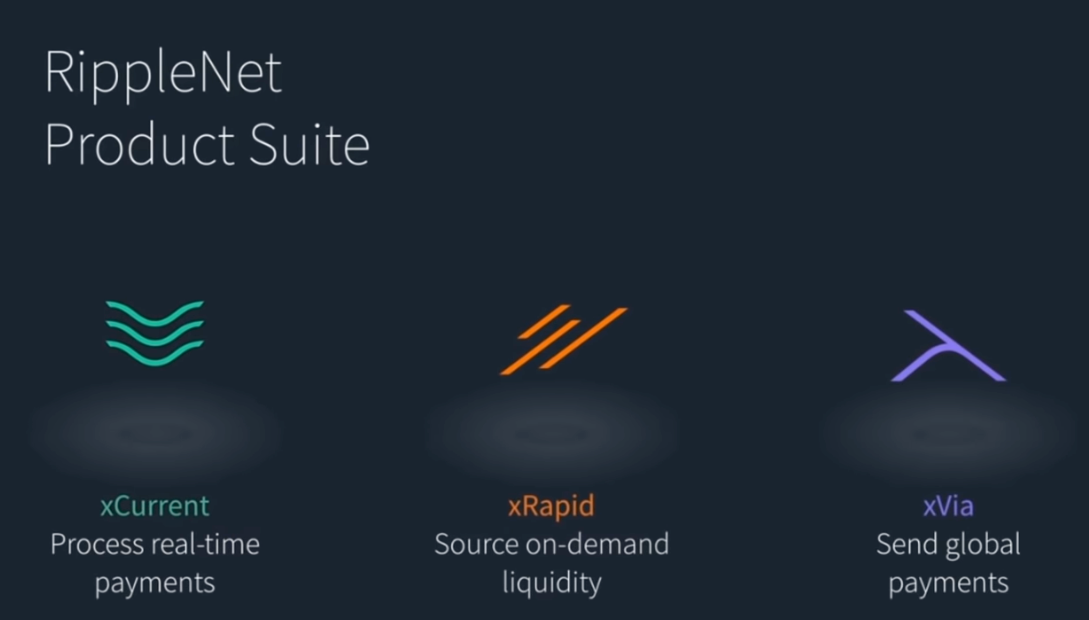
How Ripple Works
Ripple uses the Interledger Protocol (ILP), an open-source protocol used for making payments across different networks. It does so by connecting ledgers from different banks using API connectors, thus removing the need for human intervention.
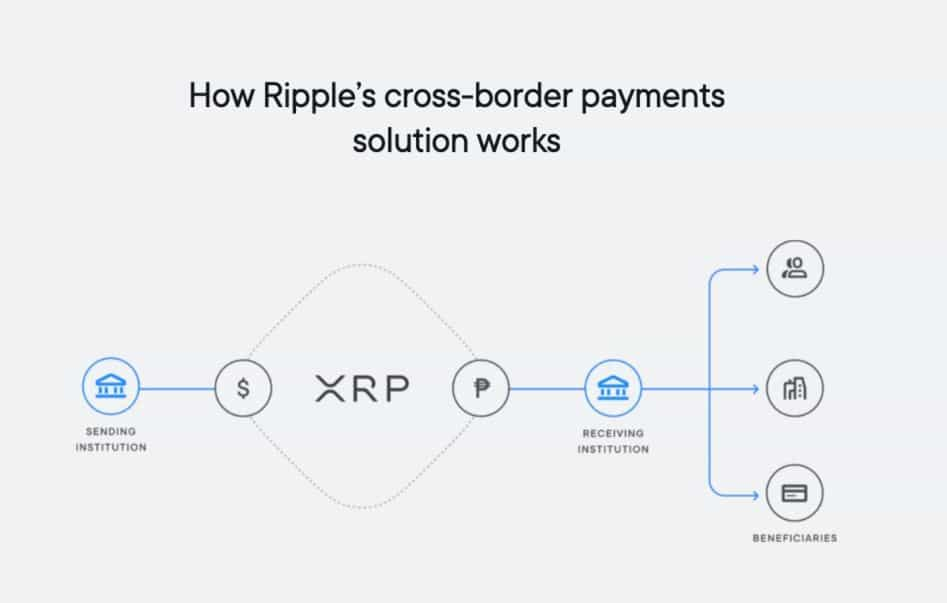
The transference of funds occurs via connectors or nodes in the network known as inter-ledgers. This is possible due to the concept of cryptographic escrow, which is similar to a two-phase commit protocol. The first phase is where the user sets the conditions for the transaction to go through or be cancelled. The second phase is to outline the transaction process once the conditions are met. If the transaction is successful, then the recipient receives the funds. If not, the funds are returned to the sender.
Payment information is passed from one ledger to another like the baton handed over from one relay racer to another. The key piece of information throughout this relay is the interledger address. It corresponds to the addresses of the accounts in the Ripple Network, which links to other ledgers through a connector. Note that the information transferred by the Interledger Protocol contains the barest bits necessary to identify a transaction.

Under “atomic mode”, which is utilised by xCurrent, once the package of information reaches the Ripple Consensus Ledger (RCL), that's when the notaries get into action and will verify and validate transactions. This mode requires trusted connector nodes, thus it is suitable for use by banks or financial companies as they may already know each other.
The other mode, known as “Universal Mode” does not require notaries. Instead, XRP, the native token is used to facilitate transfers that are time-constrained. The transactions will be voided if they do not happen within the stipulated timeframe.
XRPL Infrastructure
XRP operates on XRP ledger (XRPL), its decentralized, open-source blockchain, and transactions are facilitated by the Ripple transaction protocol (RTXP).
In this current form, XRPL faces infrastructure challenges, including a lack of flexibility, efficiency issues, and financial burdens for both companies and individuals. The current system lacks incentives for infrastructure hosts and struggles with storage demands despite its fast transaction speed. Together, these issues create bottlenecks and impact user trust.
To address these issues, XRPL Labs is pushing an upgrade aimed at reshaping XRPL for sustainability and inclusivity.
The revamp offers a solution by providing accessible, monetized, and efficient infrastructure options. By donating new software to the XRPL Foundation, the upgrade allows businesses and individuals to leverage public infrastructure with set limits, requiring affordable API keys should anyone exceed these limits. Major consumers contribute to the system's income, while users can connect their nodes, earning from larger consumers. This Airbnb-like model, as the company put it, incentivizes network contribution, ensuring uninterrupted services during surges or maintenance.
“This is, without a doubt, the most monumental upgrade to the XRPL infrastructure since its inception, marking a pivotal moment in our pursuit of a healthier." - XRPL Labs
How Is the XRP Ledger Network Secured and Efficient?
Unlike most public blockchains that use either Proof-of-Work (PoW) like Bitcoin or some flavour of Proof-of-Stake, Ripple uses their own style called the Ripple Protocol Consensus Algorithm (RPCA) to secure its ledger. The RPCA works by “majority rule” and this is how it works:
The latest batch of transactions is collected together and made public in list form called “Candidate Set". Each validator votes to decide whether transactions are truthful or not. If they reach 50% approval, they get sent onward to obtain the next round of approvals. Those that didn't get enough votes will either be discarded or held for the next round later.
At this juncture, I want to point out that each validator has a Unique Node List (UNL), which is a set of other validators that the validator queries when attempting to reach a consensus. Only the votes from these validators are taken into consideration for consensus agreement. These validators are assembled by RippleLabs and are trusted by them not to try to defraud the network. Note too that the UNL is recommended by Ripple with periodic updates to include new validators.
In the second round, the transactions need to obtain at least 80% approval from the validators in the UNL in order to be written to the ledger as confirmed transactions. Once that's done, that ledger will be officially “closed", known as the last-closed ledger.
Both the security and efficiency of the Interledger protocol stem from the fact that this is pretty much a semi-closed-door system. The validators who make it to the Unique Node List are practically hand-picked by RippleLabs based on whatever criteria they have, so they bear quite a bit of responsibility for ensuring the network stays stable and healthy and hopefully, hack-free. On the other hand, if there is any collusion happening, it would have to involve almost all the validators on the list and that would be even more scandalous than FTX absconding customer funds.
As the votes needed for the second round mainly come from the UNL participants, that's fewer people to ask around to reach a consensus, which is where the efficiency comes in. It's also worth taking note that validators don't get XRP as a reward like most blockchain validators do. Their incentive to perform in good faith is likely related to the fact that they have their own skin in the game, i.e. the organisations they belong to might also be RippleNet users.
What is Ripple (XRP)
The Ripple token (XRP) is a digital asset that is used on the network as a transaction fee. The cost of these transactions is approximately 0.00001 XRP. Once this has been paid, these are destroyed by the network in order to create a cost and prevent any transaction spamming of the ledger. This also makes XRP eligible to be considered a deflationary token.
Moreover, because Ripple is a digital asset with particular verifiable properties, it cannot be "faked" to any degree. This means that there is an inherent trust in the Ripple network. There were also only 100 billion XRP that were ever created. As per the Ripple Protocol, no more XRP can ever be produced or "mined".
Aside from being a form of payment for transaction fees on RippleNet, it is also used to source liquidity involving the exchanges between illiquid pairs of assets where liquidity is low. The grand goal of the team is for XRP to be the go-to reserve currency for foreign exchanges.
The XRP token can be further broken down to 1 drop, which is equivalent to 0.00001 XRP, although the XRP unit is more commonly used.
Tokenomics
On June 2nd, 2012, 100 billion XRP was generated, or known as “pre-mined” in crypto terms. The breakdown is as follows:
- 20 billion to founders, of which Jed McCaleb owns 9 billion. However, he is legally not allowed to dump the market after a lawsuit detailing his exit from the project in 2013.
- 55 billion moved to an escrow account on Dec 2017. According to the schedule, 1 billion tokens are unlocked per month to Ripple Labs for keeping the lights on. If this amount is not used, it will be placed into a new escrow account, adding another month to the release schedule.
- The rest were sold to early investors in the project and a portion of that was an initial allocation to Ripple Labs.
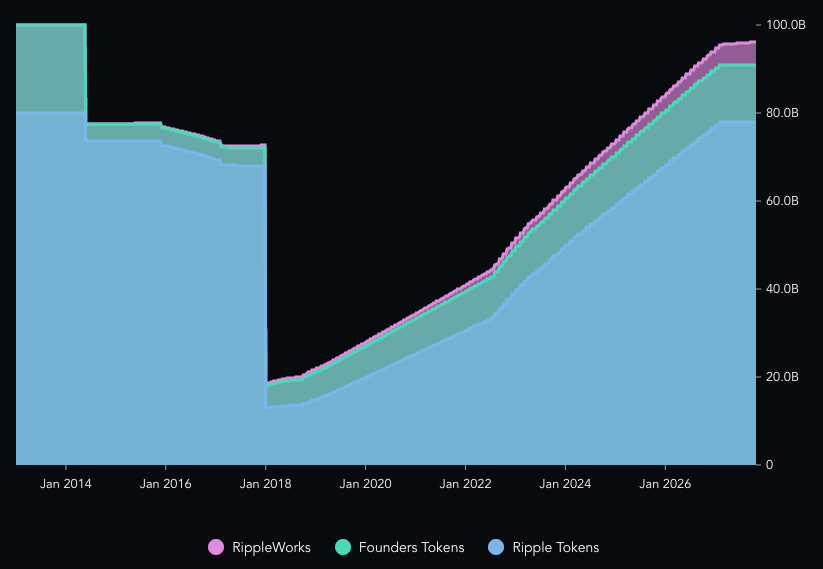
How XRP works
The genius of XRP is that it also allows for the facilitation of a transaction even if there is no chain of trust between participants. If remittance operator A has never done business with operator B before, XRP tokens can be used in exchange with the payment gateway providing a price for the transaction denominated in XRP.
Although acting as a currency of last resort is one of the purposes of the XRP token, there are a number of other advantages that make transacting with XRP so much more efficient.
XRP transactions will settle in less than 4 seconds. Hence, when it is sent on the network, the ownership of the asset changes hands almost instantaneously. This is unlike Bitcoin transactions which tend to take up to an hour, depending on network conditions. You can see a comparison in the image below of transactions per second.
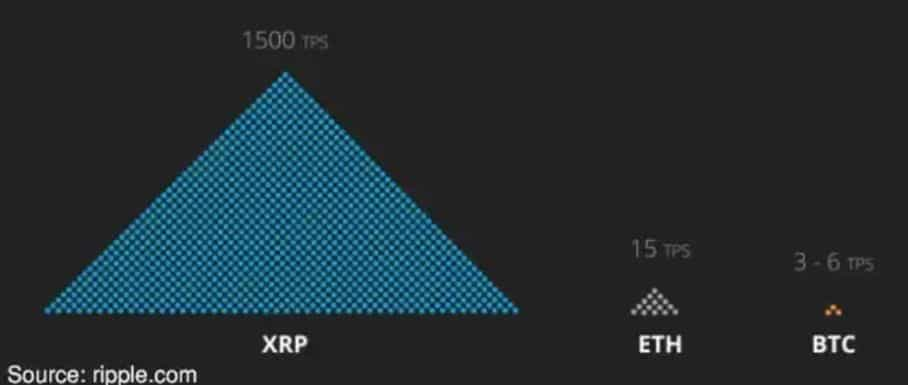
XRP Key Features
XRP is faster, cheaper, and more energy-efficient than most tokens used on public blockchains. What also makes XRP stand out from the pack is that is not looking to dethrone Bitcoin or any incumbent fiat currencies. Its role in the financial system is that of a bridging token to smooth out the kinks in cross-border payments where applicable.
RippleNet implements both fees and reserves in the ledger against malicious use and attacks. Reserves are defined as an amount of XRP that are locked in exchange for owning an object on the ledger. There are two types of reserves:
- Base reserve is the minimum amount of XRP needed to keep an account active so you can submit transactions to the network. If and when you decide to close your account for good, that's when you withdraw those reserves. That transaction is known as an account-deletion transaction in the Ripple network.
- Owner reserves is the amount of XRP the account owner needs to have for each object the account owns in the ledger. This is required on top of the base reserves.
Both reserve amounts have been adjusted since the project's inception. At the time of writing, base reserve is 10 XRP and owner reserve is 2 XRP per item.
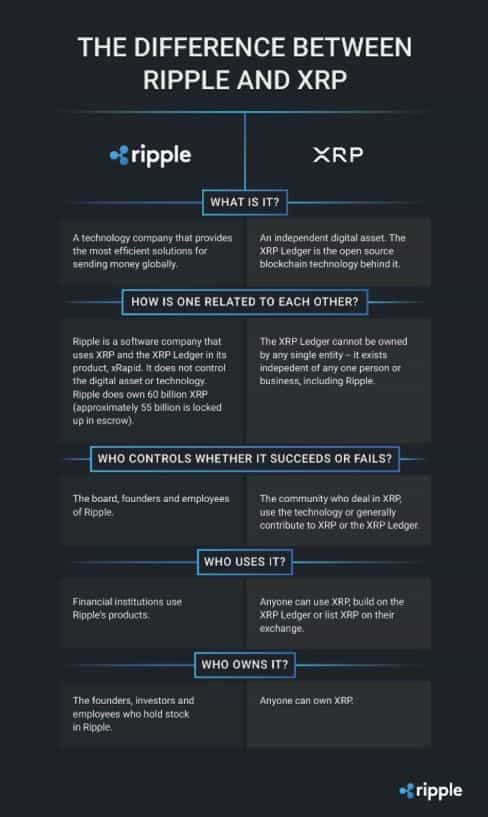
XRP Price and Potential
XRP is a regular guest in the top 10 crypto list by market cap. It's one of the more well-known mainstream cryptocurrencies after Bitcoin and Ethereum, mainly because of its 3-year-long lawsuit that is finally drawing to a close this year. The initial listed price of $0.00268621 back in 2014 has seen its fair share of ups and downs but the overall trajectory is a rocketship-style rush to the top, cumulating in an ATH of $3.40 in Jan 2018 for a brief moment.
It neared the $2 mark in 2021, which was sustained slightly longer than the ATH before finally moving down to the $0.30 - $0.40 zone during the most recent bear market.
Given that it is not a retail-facing project, its price action has been fairly volatile, in large part due to the lawsuit that's been hanging over its head like the sword of Damocles. The “is-or-isn't-it-a-security” factor has caused the price of XRP to yo-yo quite a bit. The token also has a very loyal fan base that is prepared to make their stand against any FUD directed at the project.
Retailers who invest in the project may never get to enjoy the benefits of the network directly so their investment is largely driven by the belief in the success of the project. Some institutional investors, especially those that are trialling the project for their own businesses, may see a greater incentive to see the price be kept at a certain minimum so as to safeguard their own investments.
Currently holding court at #4 in the crypto list, its fortunes are more tied to the final ruling of the lawsuit, which is anticipated to be made in the very near future, rather than its own offerings and adoption of its products.
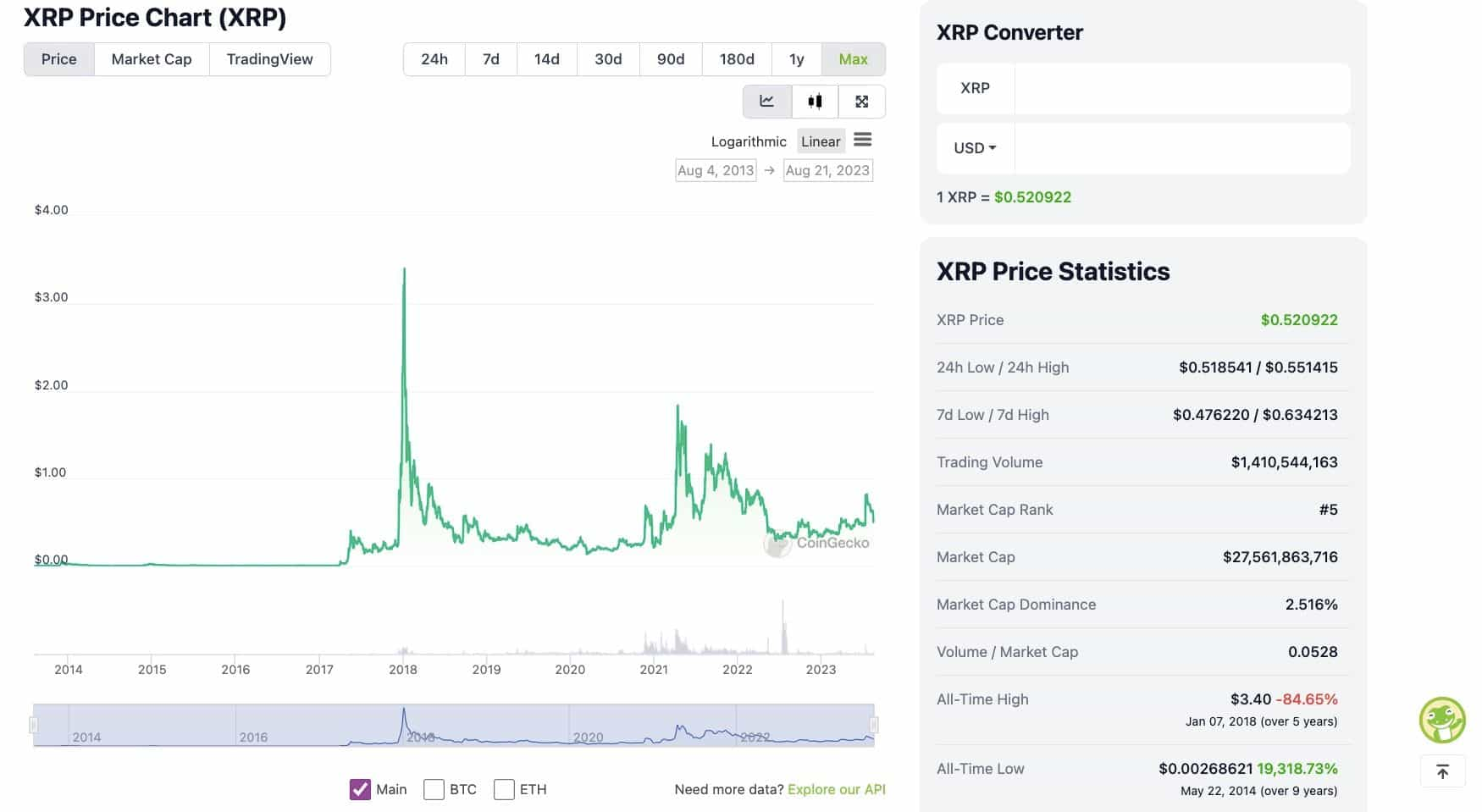
From a pure numbers perspective regarding previous price action, there is still plenty of room for the token to grow as evidenced by previous highs. Whether there is enough interest and trading to push the price up to those heights is anyone's guess, although the signs have been favorable so far. I suspect that if the final ruling were to be squarely in Ripple's favour, then it could very well reach higher prices.
Traders are likely to have a field day with this token while cautious investors are likely waiting until the dust has settled to see where things really stand.
Where to store XRP Tokens
There are a number of Ripple XRP storage options that are available to you. Perhaps the most secure option is to make use of a cryptocurrency hardware wallet such as the Ledger Nano or Trezor. This will allow you to store your tokens and easily send/receive them without exposing your private keys to the internet or your local PC environment.
You can learn more about the most secure hardware wallets trusted by us here at the Bureau in our Top Secure Hardware Wallets article. Just be sure to check that the one you choose supports your favourite digital assets.
Probably one of the most rudimentary storage options is through the use of a Ripple paper wallet. With this, you will generate a Ripple XRP address that you can then send tokens to. You will need to write down the private key and public address. Once you have sent your tokens to the address you have to use your private key in any Ripple client to send the tokens again.
While less secure than a hardware wallet, there are the more popular software mobile wallets that are a decent option as well for those not wanting to shell out the money for a hardware wallet. Some of the best mobile crypto wallets that support XRP are the likes of Trust Wallet and Exodus.
Note that you will need a minimum of 10 XRP as the base reserve mentioned above to keep the wallet active.
How to Buy Ripple Cryptocurrency
US clients may finally be able to have the opportunity to buy XRP through US-based exchanges such as Kraken and Coinbase. Non-US customers can continue to purchase XRP through other centralised exchanges like Binance and Bitget to name a few.
You can also trade XRP as a derivative Future or CFD product. This allows you to trade the token with leverage that can enhance returns and losses. If you were going to be trading it as a future then you can use the XRP Futures on the Bitmex exchange. Alternatively, if you would like to use a CFD product then you can use a broker like IQ Option or eToro.
Ripple's Foray into Stablecoins
Ripple announced in March 2024 that it would launch its own stablecoin pegged to the U.S. dollar later that year. The company plans to focus on enterprise customers and banking institutions.
The move comes amid the booming stablecoin market, with forecasts predicting it to exceed $2.8 trillion by 2028. Ripple's stablecoin will be backed by U.S. dollar deposits, Treasuries, and other cash equivalents, the company said in a statement to CoinDesk.
It will initially operate on Ripple's XRP Ledger and Ethereum blockchain using the ERC-20 token standard.
Transparency will be a key focus, CTO David Schwartz told CoinDesk, with plans for regular public audits by a “top-tier accounting firm.” He said the stablecoin venture is a long-term play with a focus on building trust and utility in the market.
Top Projects on Ripple (Ripple DApps)
The XRPL Grants Program was set up in May 2021 with 1 billion tokens as the initial seed investment to encourage software development on the XRP Ledger. It recently closed its 6th round of applicants and is currently reviewing the entries. To give you an idea of the grant size, round 5 had 15 winning projects that were granted a total of $1.6 million.
Results for round 6 will be announced in September. Past recipients include but are not limited to:
Evernode - a permissionless, flexible, and scalable L2 smart contract network
Bithomp - one of the most popular XRPL explorers
GateHub - an explorer to track GateHub's insurances on the XRP Ledger
NFT.cafe - a NFT marketplace for NFTs on XRP
Space Mermaids - a fun web-based game where you are a space mermaid collecting hearts and stars while avoiding a collision with asteroids.
Ripple and the SEC
Back in 2020, Ripple was the first crypto project to fall squarely in the SEC's crosshairs. SEC said that Ripple violated existing securities laws by selling $728.9 million worth of XRP directly to institutional investors as an unregistered security. This is because investors expect to profit from work done by the Ripple team, which is one of the conditions of the Howey Test. This test is a set of rules that defines a security in the eyes of the SEC. In response, Ripple then filed a Wells Submission with the SEC and also asked that the charges be dismissed.
On July 13th, an early ruling stated that institutional purchases of XRP are considered securities, while retail purchases of XRP aren't. This has prompted compliant exchanges such as Kraken and Coinbase to make XRP available to US customers once again. Ripple is fairly confident that the ruling could result in renewed interest in US banks to incorporate Ripple's products into their existing system. Following this partial win by Ripple, the SEC appealed the ruling, but the judge shot it down. More recently, the SEC dropped claims against Ripple CEO Brad Garlinghouse and co-founder Chris Larsen.
In stark contrast to Ripple's troubles in the U.S., Asia has been much more welcoming with the company recently securing a digital asset license from the Monetary Authority of Singapore.
Companies Building With Ripple
Aside from the institutional investors who are giving their own investment a trial, other non-US banks are apparently also testing the waters with Ripple, including a number of Japanese banks. The list also includes the Bank of England and ANZ Bank in Australia and New Zealand amongst others. I am unable to verify the accuracy of that list but I thought it was of interest and worth sharing.
Ripple Review: Closing Thoughts
Ripple is definitely keen to upend the way the remittance and cross-border payments businesses are structured. With its solid payment protocol that seeks to eliminate all unnecessary middlemen involved in a simple cross-border transfer, it brings much-needed and greater efficiency to the banking system that is running on multi-decade-old technology and in dire need of an upgrade.
Existing arrangements like nostro/vostro accounts could be a thing of the past as more banks and financial institutions sign up to join the Ripple bandwagon. This is a very plausible scenario since Ripple poses less of a threat to the banks (assuming they're ok to give up the luscious fees they charge consumers) but more to settlement layers like SWIFT.
While the network itself cannot be controlled by a single entity, the validators are limited compared to the ones for a public blockchain, which gives it that whiff of centralisation that is familiar to conservative entities. The lawsuit with the SEC is a significant event in Ripple's history books and has huge implications for its future development in both the US and worldwide.
One thing is certain, Ripple has seen its share of both stormy and sunny days and it takes a certain level of tenacity to be around for as long as it has. While there may have been some whisperings of slightly unsavoury practices floating in the crypto community, on paper, it's at least a solid enough project to have the legs to continue the crypto marathon.
Frequently Asked Questions
Ripple and Ethereum are like apples and oranges, neither is better nor worse than the other. The areas they are involved in are completely different. Ripple works with financial institutions to expedite cross-border money transfers. Ethereum is the underlying infrastructure that powers the development of various decentralised applications.
US customers can finally use cash to buy XRP through major exchanges such as Coinbase and Kraken. Non-US customers around the world can buy XRP through centralised exchanges like Binance, Bitget and others.
Ripple has lined up many major financial institutions to be their customers, partners, or investors. As long as it has the support of these institutions and no better tech comes along, it should be around for a long time.
Ledger and Trezor are the best all-round cold wallets for crypto, including XRP. Check out the hardware wallets on our Deals Page for some of the best discounts in the industry.
Some solid free (though less secure) mobile wallets to store XRP are the likes of Exodus and Trust Wallet.
Ripple, short for Ripple Labs, is the company that created the Ripple Network. The network uses XRP as the native token to pay for transaction fees incurred by users of the network.
Ripple targets businesses, banks, and payment providers as their core customer base. Major banks such as Standard Chartered, WestPac, and Santander Bank from Spain are some of the big players.
Out of the fixed supply of 100 billion XRP coins, about 50 billion of them are in circulation.
Ripple is a blockchain network with a payment protocol that allows for payments to be settled between two parties at a very low cost at near-instant time.
Disclaimer: These are the writer’s opinions and should not be considered investment advice. Readers should do their own research.


